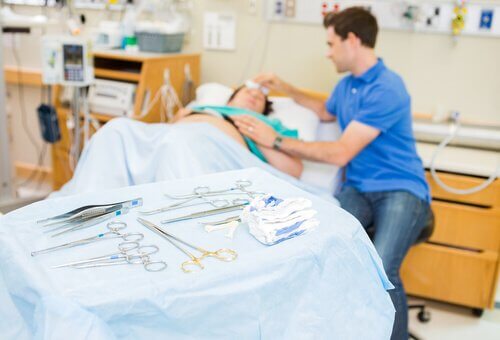When Are Assisted Deliveries Necessary?

Assisted deliveries are vaginal deliveries where doctors must use certain tools or instruments to help the baby out through the birth canal.
Doctors have used these methods for years, and even centuries with midwives. These tools are so old, there are even records of assisted deliveries in traditional Indian medicine books. They’re called Ayurveda, which date back to a thousand years before Christ.
Now, although these tools have existed for a while, many women wonder why doctors use them, and in what specific cases. If you need them, don’t miss out on the information we’ll give you below. We’ll tell you everything you need to know on this topic.
When are assisted deliveries necessary?
The OB/GYN will decide whether or not they need to use tools. It will all depend on whether or not the delivery process has taken longer than expected. The goal of assisted deliveries is to protect the mother and baby.
These tools are also used when the baby is in a position that makes it difficult to go through the birth canal. Therefore, the mother can’t deliver her baby on her own and needs help.
Sometimes, mothers have other health issues that may require assisted deliveries – for example, eye problems like keratoconus, retinal detachment, heart disease or lung problems.
It’s important to clarify that assisted deliveries have certain restrictions. Therefore, they’re only used when the baby has already passed through the pelvic area and is already close to the final phase.

Tools used in assisted deliveries
The three most common medical tools in assisted deliveries are forceps, spatulas, and suction cups. We must emphasize that to use any of these tools, mothers need to have an epidural. This way, they won’t feel pain or pressure in the vaginal canal.
Forceps
This is one of the oldest obstetric instruments. In fact, it dates back to England, around 1631. Basically, they’re metal pliers in the shape of two panels, kind of like scissors.
Doctors insert them into the vaginal canal. Then, they hold the baby’s head to rotate and readjust his position. Also, they’ll make traction to get the baby out of the birth canal.
“These tools are also used when the baby is in a position that makes it difficult to go through the birth canal. Therefore, the mother can’t deliver her baby on her own and needs help.”
However, this tool is a bit controversial. Although doctors have used it for centuries and get good results, its success ultimately lies in using it correctly. That way, they won’t hurt the mother or baby. Next, we’ll show you its pros and cons.
Pros
- Allows proper rotation of the baby.
- The baby exits almost immediately, so there is no need for a cesarean section.
Cons
- Can cause cuts or lacerations for the mother and baby.
- Produces prolapses in the cervix and anal sphincter, in addition to urinary incontinence.
- Possible damage to the baby’s facial nerves.
- In rare cases, it could fracture the baby’s collar bone or cause internal bleeding.
Spatulas
This tool is similar to forceps, but it only has one handle, not two. It helps the baby leave the birth canal by guiding his head.

Suction cups
These are cup-shaped instruments that can be metallic, silicone or plastic. Doctors insert it into the vaginal canal on the baby’s head, then connect it to a pump. They suck to help the mother while she pushes the baby.
As a final piece of information, assisted deliveries are very safe for both the mother and baby. This is true as long as your specialist performs it.
In addition, to be successful, doctors must only use these tools when the baby is in the vaginal canal and almost at the end. They aren’t a replacement for emergency cesarean sections.
Assisted deliveries are vaginal deliveries where doctors must use certain tools or instruments to help the baby out through the birth canal.
Doctors have used these methods for years, and even centuries with midwives. These tools are so old, there are even records of assisted deliveries in traditional Indian medicine books. They’re called Ayurveda, which date back to a thousand years before Christ.
Now, although these tools have existed for a while, many women wonder why doctors use them, and in what specific cases. If you need them, don’t miss out on the information we’ll give you below. We’ll tell you everything you need to know on this topic.
When are assisted deliveries necessary?
The OB/GYN will decide whether or not they need to use tools. It will all depend on whether or not the delivery process has taken longer than expected. The goal of assisted deliveries is to protect the mother and baby.
These tools are also used when the baby is in a position that makes it difficult to go through the birth canal. Therefore, the mother can’t deliver her baby on her own and needs help.
Sometimes, mothers have other health issues that may require assisted deliveries – for example, eye problems like keratoconus, retinal detachment, heart disease or lung problems.
It’s important to clarify that assisted deliveries have certain restrictions. Therefore, they’re only used when the baby has already passed through the pelvic area and is already close to the final phase.

Tools used in assisted deliveries
The three most common medical tools in assisted deliveries are forceps, spatulas, and suction cups. We must emphasize that to use any of these tools, mothers need to have an epidural. This way, they won’t feel pain or pressure in the vaginal canal.
Forceps
This is one of the oldest obstetric instruments. In fact, it dates back to England, around 1631. Basically, they’re metal pliers in the shape of two panels, kind of like scissors.
Doctors insert them into the vaginal canal. Then, they hold the baby’s head to rotate and readjust his position. Also, they’ll make traction to get the baby out of the birth canal.
“These tools are also used when the baby is in a position that makes it difficult to go through the birth canal. Therefore, the mother can’t deliver her baby on her own and needs help.”
However, this tool is a bit controversial. Although doctors have used it for centuries and get good results, its success ultimately lies in using it correctly. That way, they won’t hurt the mother or baby. Next, we’ll show you its pros and cons.
Pros
- Allows proper rotation of the baby.
- The baby exits almost immediately, so there is no need for a cesarean section.
Cons
- Can cause cuts or lacerations for the mother and baby.
- Produces prolapses in the cervix and anal sphincter, in addition to urinary incontinence.
- Possible damage to the baby’s facial nerves.
- In rare cases, it could fracture the baby’s collar bone or cause internal bleeding.
Spatulas
This tool is similar to forceps, but it only has one handle, not two. It helps the baby leave the birth canal by guiding his head.

Suction cups
These are cup-shaped instruments that can be metallic, silicone or plastic. Doctors insert it into the vaginal canal on the baby’s head, then connect it to a pump. They suck to help the mother while she pushes the baby.
As a final piece of information, assisted deliveries are very safe for both the mother and baby. This is true as long as your specialist performs it.
In addition, to be successful, doctors must only use these tools when the baby is in the vaginal canal and almost at the end. They aren’t a replacement for emergency cesarean sections.
This text is provided for informational purposes only and does not replace consultation with a professional. If in doubt, consult your specialist.








